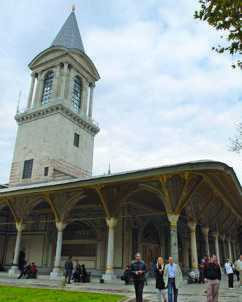Istanbul’s Topkapı Palace in transformation
ISTANBUL

Works, some of which marked a first, aim to return Topkapı Palace to its original form.
Topkapı Palace, regarded as the most important heritage site in Istanbul’s historic peninsula, has recently been enhanced with some new arrangements and renovations, after becoming a museum. These works marked a first for the palace.
According to a written statement made by the Culture and Tourism Ministry, many sections in the historical Ottoman palace have undergone restoration works since Culture and Tourism Minister Ömer Çelik took the position in January. Also, many new applications started in the palace.
The palace regained the Ottoman soul with the recent works that aimed to render the palace true to its original form. Visitors of the palace can travel back in time thanks to new applications featuring the traditions of the past.
The pools of the palace, which were constructed in 1478 by Fatih Sultan Mehmet and served as the governmental center of the state and official residence of sultans for 380 years, were reactivated. Ten pools in the seraglio and garden of the palace are now operating following the works.
Among these pools, the most important one is called “Selsebil” with 19 taps in the Privacy Chamber (Has Oda) of Murad III.
That two prayer rooms in the seraglio of the palace were renovated to regain their original appearance and recovered by the museum is shown as a big progress. These prayer rooms, Karaağalar and Kadınlar, which served as depots after the palace became a museum, are set to open to visits within a month.
The prayer rooms are expected to change the concept of seraglio in people’s minds. Also, tile panels with the Kaaba motif in the Karaağalr room are extremely precious elements of the museum’s tile collection.
The Kadınlar room draws attention for a unique practice. Women accompany the community and imam behind a cage.
 Restoration in Sacred Relics
Restoration in Sacred RelicsWorks aiming to return Topkapı Palace to its original form also continued with the restoration in one of the best known sections in the palace, Sacred Relics (Kutsal Emanetler). The whole collection of the sacred relics were cleaned and restored, 100 years after sultan Reşad’s term. Visits to Hırka-ı Şerif on the 15th day of the month of Ramadan became possible again in September 2012.
Within the scope of the works, the historic Gülhane (rose garden) was reconstructed in the Topkapı Palace. Around 40,000 roses were planted in the historic Gülhane, whose name resembles that of Gülhane Park, which was opened in the Turkish Republic Period.
Also, half a million hyacinths and tulips were planted in the museum, and special hyacinth and tulip gardens were opened. With the contributions of Isparta-Güneykent Municipality, the Isparta scented rose garden was also opened.
The gendarmerie team which protects the Topkapı Palace will serve with a novel service concept from now on. Soldiers forming part of a new horse rider team will serve in the palace wearing historical dress.
The military Janissary Band concerts, which are organized outside the palace from time to time, will perform every Wednesday at 11 a.m. in the Divan Avlusu.
Another innovation in the Topkapı Palace Museum is the Merkez Yazma Eserler Kütüphanesi (Manuscripts Library). The library in the museum began serving again after seven years. The palace archive will serve online for the first time. Catalogues in the palace archive are already in service online.
Other works in the palace
The restoration of the Imperial Hall, which is the private meeting area in the seraglio, has been completed. Also, the Zülüflü Baltacılar Ocağı (Dormitories of the Halberdiers with Tresses) was reorganized as a historic military post and will open soon.
All the gravure and drawing collections of the palace, including the map of Piri Reis, were put on display and their catalogues were printed.
The Topkapı Palace Museum Yearbook was prepared again after 18 years and sent to print.
Many new applications were put into practice in the Topkapı Palace Museum, too. The tradition of reading the Miraciye (Prophet Muhammed’s ascent to heaven) began in the palace on the night of Miraj.
It is similar to to the tradition of reading the Mevlit (Islamic memorial service) on the holy night, which marks the birth of Prophet Mohammed.
The conference hall, Enderun School (a special school in the Ottoman times) and seraglio of the palace will only host museum concerts and conferences.

 Restoration in Sacred Relics
Restoration in Sacred Relics